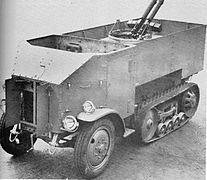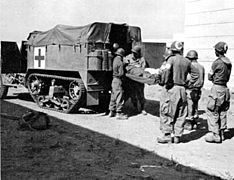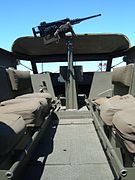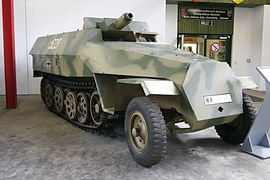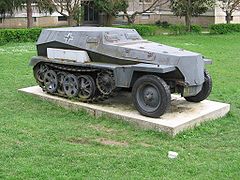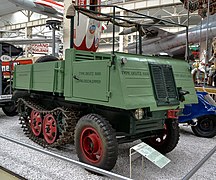Half-track
This articleneeds additional citations forverification.(January 2013) |

Ahalf-trackis a civilian ormilitary vehiclewith regular wheels at the front for steering andcontinuous tracksat the back to propel the vehicle and carry most of the load. The purpose of this combination is to produce avehiclewith thecross-country capabilitiesof atankand thehandlingof awheeledvehicle.
Performance
[edit]The main advantage of half-tracks over wheeled vehicles is that the tracks reduce the pressure on any given area of the ground by spreading the vehicle's weight over a larger area, which gives it greater mobility over soft terrain like mud and snow, while they do not require thecomplex steering mechanismsof fully tracked vehicles, relying instead on their front wheels to direct the vehicle, augmented in some cases by track braking controlled by the steering wheel.
It is not difficult for someone who can drive a car to drive a half-track, which is a great advantage over fully tracked vehicles, which require specialized training. Half-tracks thus facilitate moving personnel and equipment successfully across varying terrain.
The main disadvantage is the increased maintenance to maintain track tension, and the reduced life span of tracks (up to 10,000 km) compared to tires (up to 80,000 km).
History
[edit]Kégresse track
[edit]

The French engineerAdolphe Kégresseconverted a number of cars from the personal car pool of TsarNicholas II of Russiato half-tracks in 1911. His system was named after him: theKégresse track,which used a flexible belt rather than interlocking metal segments. He applied it to several vehicles in the imperial garage, includingRolls-Roycecars andPackardtrucks. TheImperial Russian Armyalso fitted the system to a number of theirAustin Armoured Cars.From 1916 onward, there was a Russian project by thePutilov Plantto produce military half-tracks (the Austin-Putilov model), along the same lines, using trucks and French track parts.
After theRussian Revolutionand the establishment of theSoviet Union,Kégresse returned to his native France, where the system was used onCitroëncars between 1921 and 1937 for off-road and military vehicles.
Steam log hauler
[edit]

The concept originated with the hauling of logs in the northeastern US, with theLombard Steam Log Haulerbuilt byAlvin LombardofWaterville, Maine,from 1899 to 1917. The vehicle resembled a railway steam locomotive, with sled steering (or wheels) in front and at the rear, crawlers driven by chains instead of the driving wheels of a locomotive.[1]
By 1907,dog and pony showoperator H. H. Linn abandoned his gas-and-steam-powered four- and six-wheel-drive creations and had Lombard build a motor home/traction engine run by an underslung four-cylinder Brennan gasoline engine to travel the unimproved roads of the day, with wheels at the front and tracks at the rear: the first payload-carrying half-track. By 1909 this was replaced by a smaller machine with two wheels at the front and a single track behind, since rural wooden bridges presented problems.
Stability issues, together with a dispute between Linn and Lombard, led Linn to create the Linn Manufacturing Company, builder of theLinn tractor,for building and putting onto the market his own improved civilian half-track–style machines. Lombard attempted to follow but, for the most part, remained a pulling machine. Linn would later register "Haftrak" and "Catruk" as trademarks, the latter for a half-track meant to convert hydraulically from truck to crawler configuration.
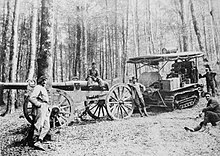

World War I
[edit]Tractorsused to towartilleryand designs with front wheels and tracks at the rear began to appear prior to the outbreak of war, often based on agricultural machines such as theHolt tractor.The basic half-track concept was originally showcased by the British during the war.
With such tractors, the tactical use of heavier guns to supplement the light horse-drawnfield gunsbecame feasible. For example, in the British Army it allowed the heavy guns of theRoyal Garrison Artilleryto be used flexibly on the battlefield. In England, starting in 1905,David RobertsofRichard Hornsby & Sonshad attempted to interest British military officials in a tracked vehicle, but failed.
Holt bought the patents related to the "chain track"track-type tractorfrom Richard Hornsby & Sons in 1914[2]for £4,000. Unlike the Holt tractor, which had a steerable tiller wheel in front of the tracks, the Hornsby crawler was steered by controlling power to each track.[3]
When World War I broke out, with the problem oftrench warfareand the difficulty of transporting supplies to the front, the pulling power ofcrawling-typetractors drew the attention of the military. With tanks coming onto the scene, however, the combination of tracks and wheels seemed impractical when fully tracked or six-wheel, four-wheel drive vehicles were available.
The half-track saw a comeback in the 1930s, with development occurring in several countries that would use them in World War II. The White Motor Company, which had designed armored cars for theUnited States ArmyandUnited States Marines,continued after the First World War to develop armored cars and added tracks for theM2 half-track carandM3 half-track.
Autochenilleandautoneige
[edit]There were many civilian half-track experiments in the 1920s and 1930s. TheCitroëncompany sponsored several scientific expeditions crossing deserts in North Africa and Central Asia, using theirautochenilles.After World War I, the US military wanted to develop a semi-tracked personnel carrier vehicle, so it looked at these civilian half-tracks. In the late 1920s the US Army purchased several Citroën-Kégresse vehicles for evaluation followed by a licence to produce them. This resulted in the Army Ordnance Department building a prototype in 1939. In September 1940 it went into production with the military M2 and M3 half-track versions.

With the snow and ice ofCanadain mind,Joseph-Armand Bombardierdeveloped 7- and 12-passenger half-trackautoneigesin the 1930s, starting what would become theBombardierindustrial conglomerate. The Bombardier vehicle had tracks for propulsion in the rear and skis for steering in front. The skis could be replaced with wheels in the summer, but this was uncommon.

The Red Army also experimented with half-tracks, such as theBA-30,but found them expensive and unreliable. Although not a feature on American World War II vehicles, steering could be assisted by track braking, controlled by the steering wheel.
World War II half-track use
[edit]
In the US, 43,000 halftracks were produced by three primary manufacturers, the largest being theWhite Motor Company,the original designer, with a total of 15,414 accepted by the War Department. The other manufacturers,AutocarandDiamond T,built 12,168 and 12,421, respectively. These designs were produced under license in Canada, and were widely supplied under theLend Leaseprogram, with 5,000 supplied to the USSR alone.[4]

The fourth manufacturer of American-made half-tracks was the International Motor Truck Corporation division ofInternational Harvester.IH built approximately 12,853 half-tracks, which were shipped to Europe for use by British and French troops. In 1942, they produced 152 M5 units and 5 M14 units at the Springfield Works; in 1943 they produced 2,026 M9 units, 1,407 M0A1 units, 4,473 M5 units, 1,600 M14 units, and 400 M17 units, all at the Springfield Works; in 1944 they produced 1,100 M5A1 units and 1,100 M17 units also at the Springfield Works; and in 1945 they built 589 M5A1 and 1 M5A3 units at Springfield Works. The IHC half-tracks differed visibly from the White, Diamond T, and AutoCar units in several ways. The IHC units had flat front fenders instead of fenders with compound curves; used the International Red Diamond 450 engines instead of the Hercules 160AX engines used by the other manufacturers; used IHC Model 1856 4-speed transmissions instead of the Spicer 4-speed transmissions used by the other manufacturers; had IHC Model FOK-1370 front drive axles instead of the Timken front axles used by their competitors; used IHC Model RHT-1590 axles in the rear instead of the Timken axles used by their competitors; and were constructed with fully welded armor with rounded rear corners instead of the bolted armor with square corners used by the other three manufacturers.[5]
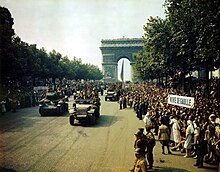
In August 1944, Allied forcesliberated Paris.The first vehicle to enter the city was an M3 named "España Cañí" and driven by Spanish soldiers fighting under the French tricolor. There followed several days of parades in late August. One parade of 25 August 1944 was down theChamps-Élysées,withCharles de Gaulleleading throngs of Parisians, and French soldiers driving IH half-tracks.
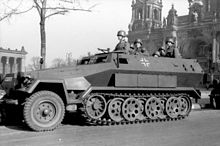
Infantry transporters
[edit]Half-tracks were used extensively in World War II, especially by the Germans with their armoredDemag-designedSd.Kfz. 250sandHanomag-designedSd.Kfz. 251s;and by the Americans with theirM2sandM3s.
Support weapon platforms
[edit]Half-tracks were widely used asmortar carriers,self-propelledanti-aircraft guns,self-propelledanti-tank guns,armored fighting vehiclesand in other tasks.

Utility and tractor half-tracks
[edit]
The Germans used a small 2 seater 1/2-ton class half-track "motorcycle", theSd.Kfz. 2(better known as theKleines KettenkraftradHK 101 orKettenkradfor short –Kettenmeaning tracks, andkradbeing the military abbreviation of the German wordKraftrad,the administrative German term for motorcycle), to pull small artillery guns, for ammunition haulage, general transport and as a ground towing vehicle for theMesserschmitt Me 262jet fighter. Built byNSU Motorenwerke AGNeckarsulmandStoewer WerkeStettin,a total of 8,345 vehicles were produced between 1940 and 1944.
Other Wehrmacht models were:
- 1-ton class,Sd.Kfz. 10produced by Demag, Berlin; Adler, Frankfurt am Main; Büssing-NAG, Brunswick; Phänomen, Cottbus and Saurer, Vienna, a total of 25,000 vehicles - its drivetrain was used for theSd.Kfz. 250
- 3-ton class,Sd.Kfz. 11produced by Hanomag, Adler, Auto-Union and Skoda from 1938 to 1944, a total of 25,000 vehicles - its drivetrain was used for theSd.Kfz. 251
- 5-ton class.Sd.Kfz. 6,manufactured by Büssing-NAG, Berlin-Oberschönweide; Daimler-Benz and Praga (Czechoslovakia), about 3,500 vehicles in total
- 8-ton class.Sd.Kfz. 7,production was of about 12,000 vehicles
- 12-ton class.Sd.Kfz. 8,some 4,000 vehicles were produced by five manufacturers
- 18-ton class.Sd.Kfz. 9,a production of only 2,000 vehicles
Larger German half-track tractors were used to tow anti-tank and field artillery pieces. The largest of these were also used by mechanical engineers to retrieve bogged down vehicles or perform repairs such as engine maintenance.Maultierhalf-tracks used to transport supplies to forward units were essentially civilian trucks which had had their rear axles replaced byPanzer IorPanzer IIrunning gear. A replacement half-track design introduced later in World War II, the 1943-introducedSchwerer Wehrmachtschlepper,was meant to replace the 3-tonne and 5-tonne capacity models – only some 825 examples were built before the war's end.
A common feature of virtually all German World War II half-tracks was the so-calledSchachtellaufwerkoverlapped/interleaved roadwheel arrangement with a "slack track" system possessing no return rollers under the return run of track, used from the smallKettenkradto the nine-tonne capacitySd.Kfz. 9vehicle, and most famously used on Henschel'sTiger Iand MAN'sPanthermain battle tanks.
Cold War use
[edit]Half-tracks were extensively used after World War II until the late 1960s, mostly in form of surplus World War II vehicles. Half-tracks saw combat in theFrench colonial empirein theFirst Indochina Warand theAlgerian War;in theIndo-Pakistani wars and conflicts;and the early wars of theArab–Israeli conflict.
Half-tracks continued in use by theIsraeli Armywhere they were deemed to outperform fully tracked and fully wheeled vehicles for non-combat payload tasks such as carrying telecommunications equipment. As of March 2008, 600 half-tracks were still officially listed as on active duty.[6]
-
Israeli modified M3 Half-track, armed with 20 mm cannon
-
GermanSd.Kfz. 11half-track
Civilian use
[edit]
Many Second World War half-tracks were sold off to civilian users either as surplus stock or later due to obsolescence when the fully trackedarmoured personnel carrierwas introduced into service. Most were used in engineering-related tasks involving terrain that would be difficult for evenfour-wheel drivetrucks, such as snow, sand and water-logged soil. Many were significantly modified for their new roles, including being fitted with winches, small cranes, and generators after the rear cabin sides were removed.
SomeWorld War IIhalf-tracks were used as all-terrainfire departmentpumpers or tankers.
Gallery
[edit]-
FirstLinn tractor,1916
-
British semi-tracked armoured personnel carrierKégresse track30cwt.
-
PreservedM9 Half-track.
-
M3 Half Track, Thunder Over Michigan.
-
Israeli M3 halftrack with Eyal crane latrun
-
M3 halftrack ambulance
-
M3 halftrack with Browning M2 machine guns
-
German halftrack at Museum of the American GIs
-
Sd.Kfz. 251/9"Stummel"
-
M5 Halftrack open top seating.
-
SOMUA MCGon display atMusée des Blindés
-
GermanSd.Kfz. 250halftrack.
-
Sd.Kfz. 9pulls tank
-
Sd.Kfz. 10
-
Imperial Japanese ArmyType 1 Ho-Ha
-
Civilian halftrackWaldschlepperas a forestry vehicle
-
Halftrack glacier crawler atHöfn
See also
[edit]Notes and references
[edit]- ^Lore A Rogers and Caleb W Scribner."Lombard Steam Log Hauler"(PDF).American Society of Mechanical Engineers. Archived fromthe original(PDF)on 2006-10-05.Retrieved6 January2009.
- ^Hoffman, George (2007-02-21)."Hornsby Steam Crawler".British Columbia.
- ^Bellis, Mary."History of Bulldozers".About.com. Archived fromthe originalon December 8, 2012.Retrieved2010-02-28.
- ^Dunn, Walter Scott,Stalin's keys to victory: the rebirth of the Red Army,p.156
- ^Crismon, Fredrerick W., "International Trucks" 1995; pp 173-174, 179, 181, 185, 186-188, 192
- ^"Israel Armed Forces"(PDF).Archived fromthe original(PDF)on 2008-08-13.Retrieved2 June2009.




